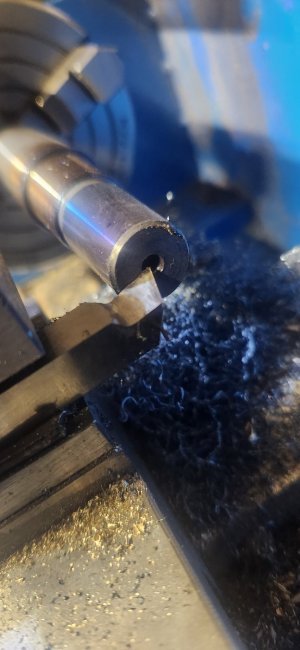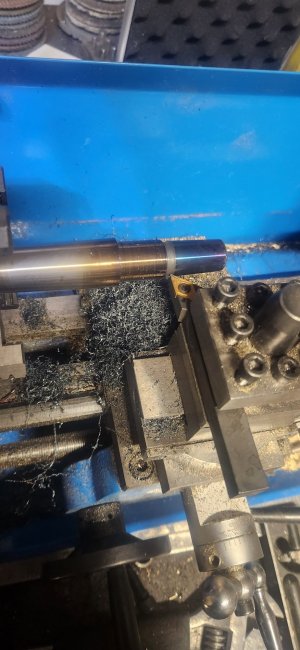@Susquatch kind of beat me to it… good points.
A 1mm depth of cut (~40 thou) [2 mm (~80 thou) off the diameter] in stainless steel seems quite aggressive to me for your lathe.
The inserts should not be glowing; they are rubbing if they do. 1/2“ tooling may be too tall for that size lathe; it is more rigid than than the smaller 3/8 tooling. If you were to use 3/8” tooling, you could shim them for correct height easier than grinding off the bottoms of 1/2” tooling. Unless you have a surface grinder (or a T&CG) it is hard to get the bottoms flat with a bench grinder. If the bottom is not flat, the tool will not sit properly on your tool post and may be pulled out of it because it flexes and you could end up with a crash. Tops of tooling can be ground off as the set screws will take care of any unevenness. Bottoms need to milled off or ground flat with some precision.
From the picture(s) you posted, those inserts are probably not the best for either SS or brass. They look too ”dull” to me.
You might be better off with sharp HSS tooling and reduced speeds. Videos I have seen shows folks using a lot of speed to compensate for the lack of torque on these smaller motors. It “burns up” inserts (or HSS tooling) and the surface finishes suffer if there are any tool height issues, no coolant is used, or the speeds & feed rates are off.
The fastest way to see if your tool is at the correct height (without a tool height gauge) is to do a facing cut. Start with the tool eyeballed slightly below center and take a cut. You then adjust the height UP in small increments until the little nub in the center you had because you were too low, gets cut off cleanly. Now you are on center.
The facing and turning tools will leave a fairly nice finish by chiping if only half a mm is cut; but if a depth of 1mm or more is cut the tool leaves a rough finish. How much force should I deliver when cutting a depth of 1mm or more?
A 1mm depth of cut (~40 thou) [2 mm (~80 thou) off the diameter] in stainless steel seems quite aggressive to me for your lathe.
The inserts should not be glowing; they are rubbing if they do. 1/2“ tooling may be too tall for that size lathe; it is more rigid than than the smaller 3/8 tooling. If you were to use 3/8” tooling, you could shim them for correct height easier than grinding off the bottoms of 1/2” tooling. Unless you have a surface grinder (or a T&CG) it is hard to get the bottoms flat with a bench grinder. If the bottom is not flat, the tool will not sit properly on your tool post and may be pulled out of it because it flexes and you could end up with a crash. Tops of tooling can be ground off as the set screws will take care of any unevenness. Bottoms need to milled off or ground flat with some precision.
From the picture(s) you posted, those inserts are probably not the best for either SS or brass. They look too ”dull” to me.
You might be better off with sharp HSS tooling and reduced speeds. Videos I have seen shows folks using a lot of speed to compensate for the lack of torque on these smaller motors. It “burns up” inserts (or HSS tooling) and the surface finishes suffer if there are any tool height issues, no coolant is used, or the speeds & feed rates are off.
The fastest way to see if your tool is at the correct height (without a tool height gauge) is to do a facing cut. Start with the tool eyeballed slightly below center and take a cut. You then adjust the height UP in small increments until the little nub in the center you had because you were too low, gets cut off cleanly. Now you are on center.


